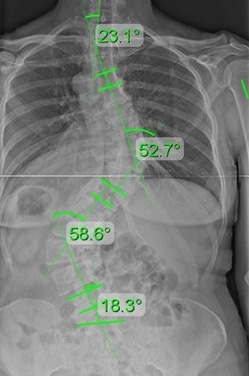Scoliosis Treatment By Age
The high risk age for scoliosis can vary.
Girls and boys have growth spurts at different ages.
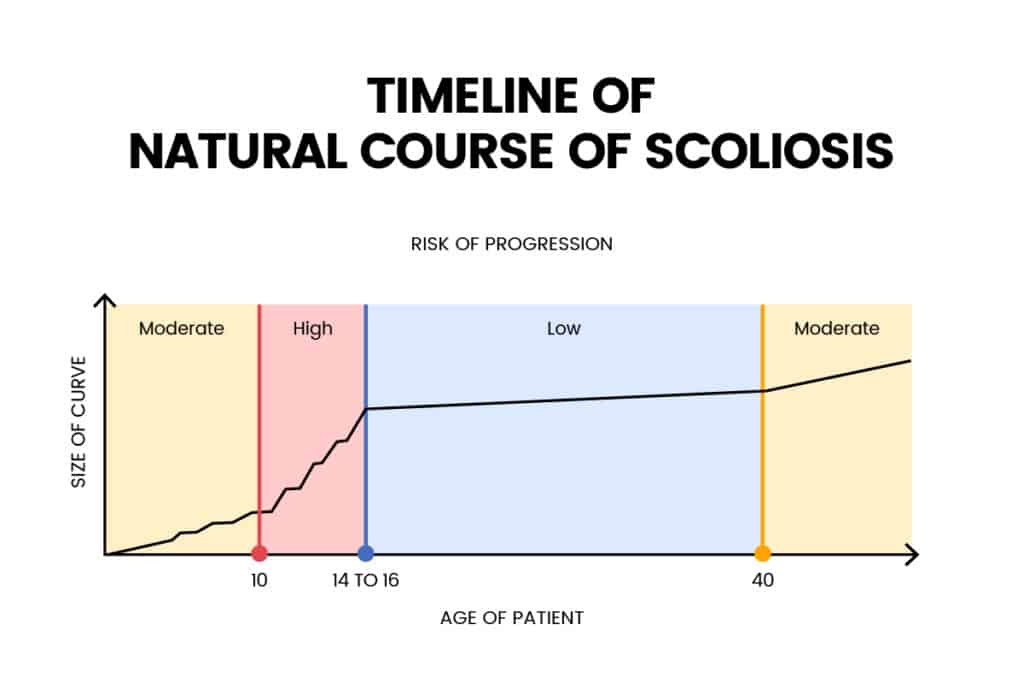
There are varying risk levels of developing scoliosis across different age groups. Children aged 0-10 are at a moderate risk, depicted in yellow, while adolescents aged 10-18 face a high risk, shown in red. This high-risk period corresponds with puberty, a critical time for scoliosis development due to rapid growth.
From ages 18 to 48, the risk significantly decreases to a low level, indicated by the blue section, reflecting fewer new cases during this phase. However, the risk increases again in individuals aged 48 and older, ranging from moderate to moderately high (yellow to orange) due to degenerative changes in the spine associated with aging.
The black line on the graph shows the cumulative risk, peaking during adolescence, stabilizing in adulthood, and rising again in older age.
As you can see, the rate of progression for scoliosis patients differs greatly by age. However, regardless of age, our goals are similar.
Goals of scoliosis treatment are as follows:
- Reduce the scoliosis
- Prevent any further progression
- Improve function and reduce pain
- Provide long term stabilization
- If a patient is going to have surgery, prepare the patient for the best possible surgical outcome.
Unfortunately, there is no method to determine when a scoliosis is first diagnosed to determine the size of the curve in the future. However, the tendency is that once curves break 25 degrees, the curve will continue to progress throughout one’s life without any treatment. Therefore, acting when a curve is smaller is almost always the best decision.
Scoliosis Treatment By Age
Click the buttons below to learn more about our treatment approach depending on the age of the patient:
Or, watch the video below to learn more about our scoliosis treatment approach by age:
Infant Scoliosis Treatment
Modified scoliosis-specific therapy and/or corrective bracing would be the most useful treatments for the age group depending on the severity of the case.
Infants (0-3 years of age) with scoliosis provide their own unique challenges. Mostly that treatment for infants will require modification from treatments that is designed for children and teens.
Pre Treatment X-Ray
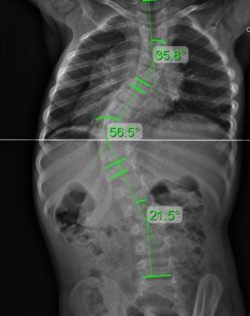
Pre Treatment Posture
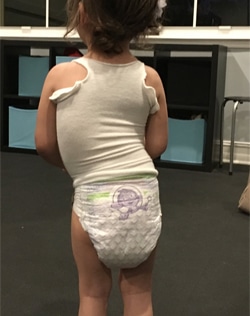
6 Weeks Into Treatment
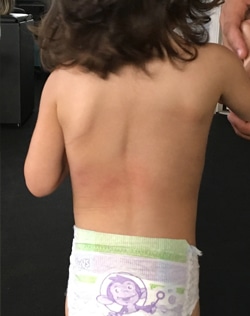
Childrens Scoliosis Treatment
Children with scoliosis between 3-10 years of age is normally the time when the best long term results can be achieved. However, this is also the time that most traditional approaches tell patients just “watch and wait.”
Depending on the curve and maturity of the patient, all treatment methods can be applied to stop progression and reduce the scoliosis to prevent invasive treatments in the future.
Pre Treatment X-Ray
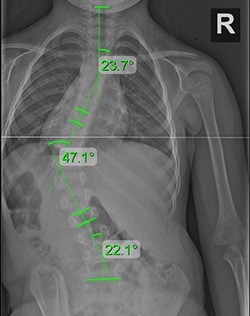
Mid Treatment X-Ray
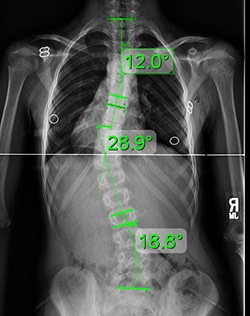
Post Treatment X-Ray
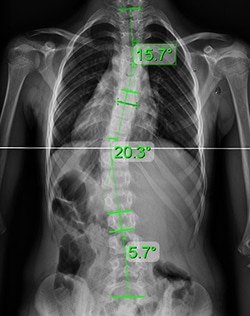
Teenagers Scoliosis Treatment
Teenagers with scoliosis is the age when most cases of scoliosis are diagnosed. This is because scoliosis is the most progressive during growth spurts that are associated with this age group.
Since curves can be progressing quickly, treatment options for this age group must be adaptive to meet the needs of a patient. Teenagers can use all of our treatment approaches to get through this most progressive stage of scoliosis in attempt to prevent further progression.
In either case, acting on the scoliosis quickly is advised due to how quickly curves can progress.
Pre Treatment X-Ray
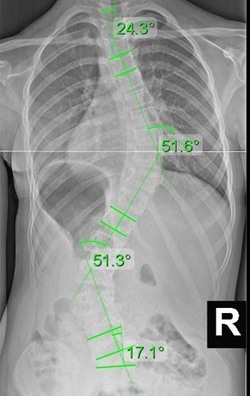
2 Weeks Into Treatment
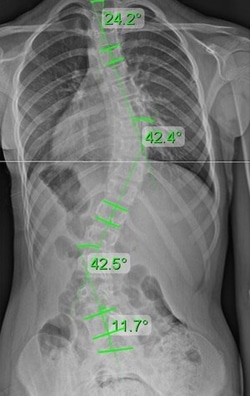
3 Weeks Into Treatment
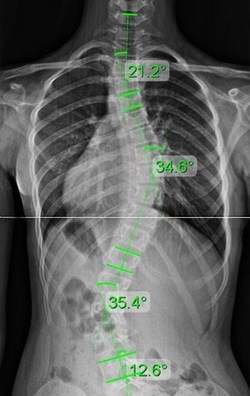
Adult Scoliosis Treatment
Adults with scoliosis are not rapidity progressing. In fact, most patients that determine they have scoliosis as an adult, is because of pain. Pain is a concern of untreated scoliosis because an unbalanced spine is more prone to degenerative changes which can lead to further progression over time. Traditionally, the only treatment option for adult patients is drugs for pain, or scoliosis surgery.
Since adult scoliosis is progressing slowly, our treatment options can get reductions in curvatures, and reduce pain simultaneously. This can prevent the need for invasive surgery. The specific scoliosis home program can help the adults with scoliosis negate the slow progressive nature of scoliosis to prevent further deterioration of their condition.
Pre Treatment X-Ray
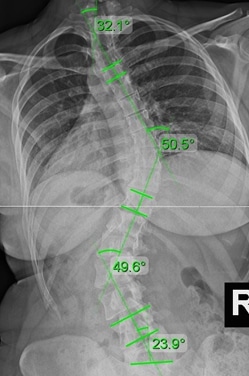
1 Week Into Treatment
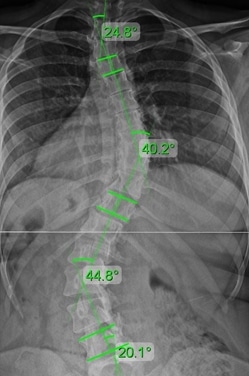
4 Weeks Into Treatment
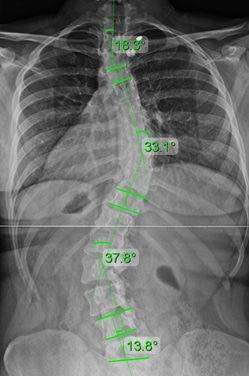
Elderly Scoliosis Treatment
Elderly patients with scoliosis can find themselves dealing with a vast amount of limitations. These limitations may not be resolved with surgery. In fact, the surgery itself may impose more limitations.
Our treatment options can help even elderly achieve a more functional spine so they can preserve their ability to perform activities of their daily life.
If limitations already exist, a modified program will be constructed based upon the ability of the patient to achieve the very best results.
Pre Treatment X-Ray
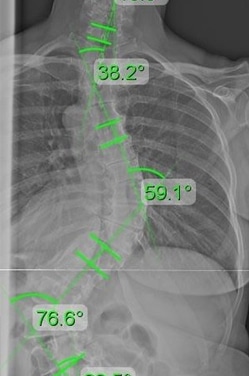
1 Week Into Treatment
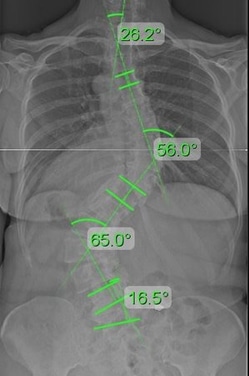
2 Weeks Into Treatment
